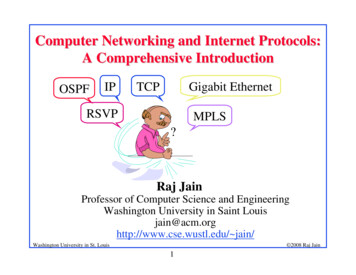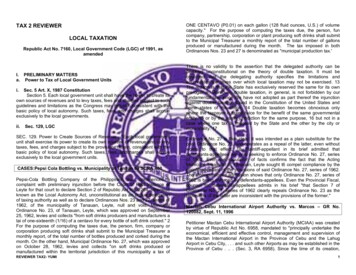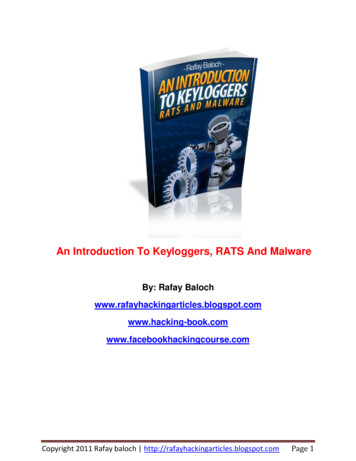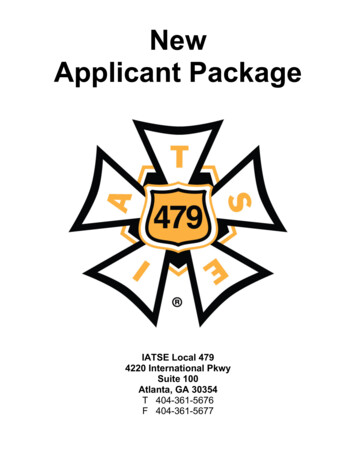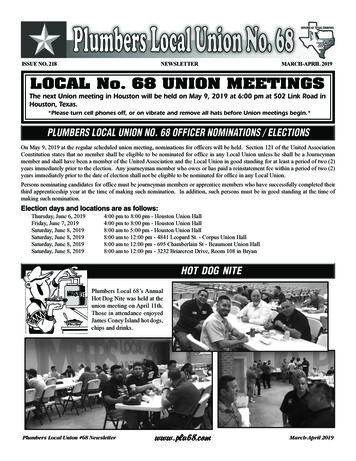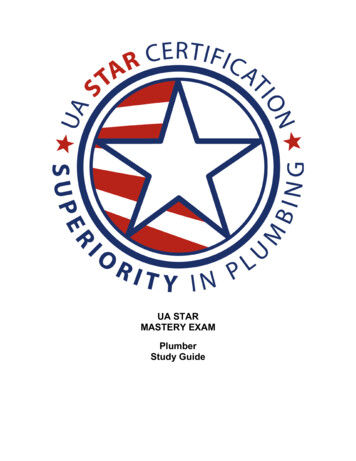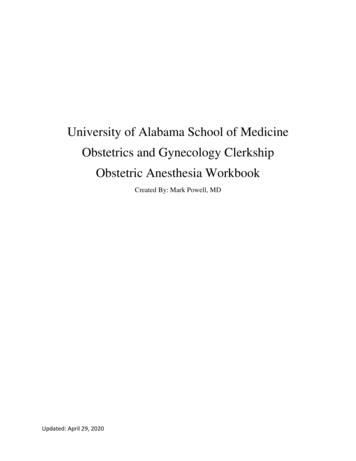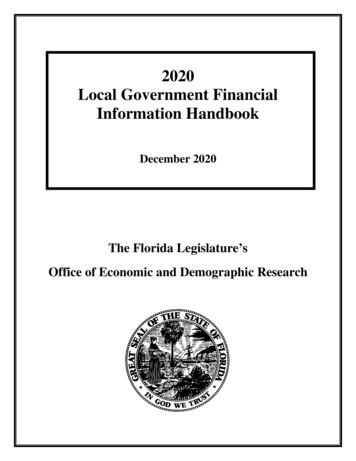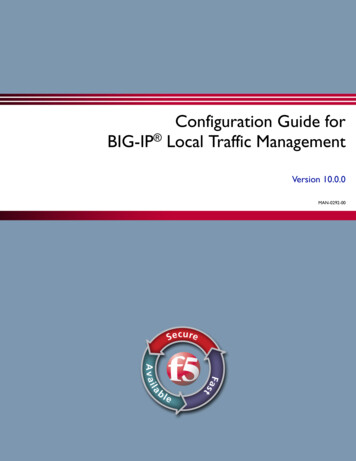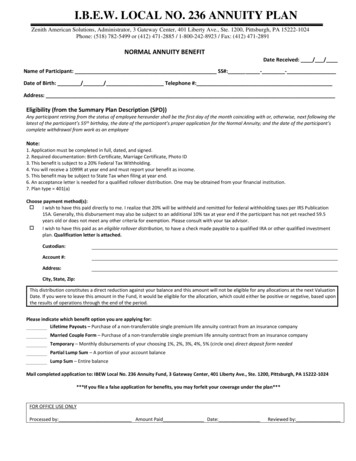
Transcription
I.B.E.W. LOCAL NO. 236 ANNUITY PLANZenith American Solutions, Administrator, 3 Gateway Center, 401 Liberty Ave., Ste. 1200, Pittsburgh, PA 15222-1024Phone: (518) 782-5499 or (412) 471-2885 / 1-800-242-8923 / Fax: (412) 471-2891NORMAL ANNUITY BENEFITDate Received: / /Name of Participant: SS#: - -Date of Birth: / / Telephone #:Address:Eligibility (from the Summary Plan Description (SPD))Any participant retiring from the status of employee hereunder shall be the first day of the month coinciding with or, otherwise, next following thelatest of the participant’s 55th birthday, the date of the participant’s proper application for the Normal Annuity; and the date of the participant’scomplete withdrawal from work as an employeeNote:1. Application must be completed in full, dated, and signed.2. Required documentation: Birth Certificate, Marriage Certificate, Photo ID3. This benefit is subject to a 20% Federal Tax Withholding.4. You will receive a 1099R at year end and must report your benefit as income.5. This benefit may be subject to State Tax when filing at year end.6. An acceptance letter is needed for a qualified rollover distribution. One may be obtained from your financial institution.7. Plan type 401(a)Choose payment method(s): I wish to have this paid directly to me. I realize that 20% will be withheld and remitted for federal withholding taxes per IRS Publication15A. Generally, this disbursement may also be subject to an additional 10% tax at year end if the participant has not yet reached 59.5years old or does not meet any other criteria for exemption. Please consult with your tax advisor. I wish to have this paid as an eligible rollover distribution, to have a check made payable to a qualified IRA or other qualified investmentplan. Qualification letter is attached.Custodian:Account #:Address:City, State, Zip:This distribution constitutes a direct reduction against your balance and this amount will not be eligible for any allocations at the next ValuationDate. If you were to leave this amount in the Fund, it would be eligible for the allocation, which could either be positive or negative, based uponthe results of operations through the end of the period.Please indicate which benefit option you are applying for:Lifetime Payouts – Purchase of a non-transferrable single premium life annuity contract from an insurance companyMarried Couple Form – Purchase of a non-transferrable single premium life annuity contract from an insurance companyTemporary – Monthly disbursements of your choosing 1%, 2%, 3%, 4%, 5% (circle one) direct deposit form neededPartial Lump Sum – A portion of your account balanceLump Sum – Entire balanceMail completed application to: IBEW Local No. 236 Annuity Fund, 3 Gateway Center, 401 Liberty Ave., Ste. 1200, Pittsburgh, PA 15222-1024***If you file a false application for benefits, you may forfeit your coverage under the plan***FOR OFFICE USE ONLYProcessed by: Amount Paid Date:Reviewed by:
I.B.E.W. LOCAL NO. 236 ANNUITY PLANZenith American Solutions, Administrator, 3 Gateway Center, 401 Liberty Ave., Ste. 1200, Pittsburgh, PA 15222-1024Phone: (518) 782-5499 or (412) 471-2885 / 1-800-242-8923 / Fax: (412) 471-2891PLEASE ANSWERAre you married as of the date of this application?If you answered YES to the above question, your spouse must sign the statement of consent attached.The following questions are required to be answered – if left blank, your application will not be processed.Were you previously married and are now either separated or divorced? Date of Divorce:If YES, does your former spouse have a claim on your account under a Separation Agreement or Judgment of Divorce?If divorced: Has your Divorce Decree and Separation Agreement been approved by the Fund Attorney?If your Divorce Decree and Separation Agreement have not been approved by the Fund Attorney, then no furtherprocessing of your application will occur until an approval from the Fund Attorney has been granted.Spousal ConsentI, , am the spouse of . I understand that I(name of participant’s spouse)(name of participant)may become eligible to have the plan named above, pay my spouse’s retirement benefit in the Normal Annuity Benefit payable inthe Married Couple Form and I agree to give up that right. I understand that by signing this agreement, I may receive less moneythan I may have received under the Married Couple form and/or Survivor Benefit payment and I may receive nothing after myspouse dies. I also understand that I cannot revoke this agreement once given.I agree that my spouse can receive this withdrawal as described on the previous page from the account in the IBEW Local No. 236Annuity Fund. I understand that my spouse cannot choose a different form of payment unless I agree to the change. I understandthat I do not have to sign this agreement and I do so on a voluntary basis. I have read the information provided in the SummaryPlan Description (SPD) with respect to my rights to the Married Couple Form and Survivor Benefit.Spouse’s Consent: Date:The person whose signature is above who is known to me and has sworn to be such spouse has affirmed such signature in mypresence this day of in the year as his or her free and voluntary actNotary SignatureAffix Seal Here:Participant’s AssertionI understand that, once I qualified under the rules of the Plan, I may apply for any of the benefit options offered above pertaining tothe remaining balance in my Annuity Account on the date the benefit is distributed.I hereby certify that I have received the attached notice entitled “Special Tax Notice Regarding Plan Payments” document on.Today’s dateI further certify that this notice is being provided to me no earlier than 90 days and no later than 30 days before the date I intend toreceive an eligible rollover distribution.I attest that the statement contained herein are true and complete. I have provided all paperwork required, including my BirthCertificate and one valid picture identification prior to processing this application.Participant’s Signature: Date:
I.B.E.W. LOCAL NO. 236 ANNUITY PLANZenith American Solutions, Administrator, 3 Gateway Center, 401 Liberty Ave., Ste. 1200, Pittsburgh, PA 15222-1024Phone: (518) 782-5499 or (412) 471-2885 / 1-800-242-8923 / Fax: (412) 471-2891Special Tax Notice Regarding Plan PaymentsThis notice contains important information you will need before you decide how to receive your Planbenefits.This notice is provided to you by the Plan Administrator because all or part of the payment that you willsoon receive from the IBEW Local 236 Annuity Plan may be eligible for rollover by you or your PlanAdministrator to a Traditional IRA or another Qualified Employer Plan. A “Traditional IRA” does notinclude a Roth IRA, a Simple IRA or an education IRA.If you have additional questions after reading this notice, you may contact your Plan Administrator at(518) 782-5499.SummaryThere are two ways you may be able to receive a Plan payment that is eligible for rollover:1. Certain payments can be made directly to a Traditional IRA or (if you choose) another QualifiedEmployer Plan that will accept a Direct Rollover; or2. The payment can be paid to you.If you choose a Direct Rollover: Your payment will not be taxed in the current year and no income tax will be withheld. Your payment will be made directly to your traditional IRA or, if you choose, to anotherQualified Employer Plan that accepts your rollover. **Your plan payment cannot be rolled overto a Roth IRA, a Simple IRA or an Education IRA because these are not traditional IRA’s. ** Your payment will be taxed later when you take it out of the Traditional IRA or the QualifiedEmployer Plan.If you choose to have a Plan payment that is eligible for rollover paid to you: You will receive only 80% of the payment, because the Plan Administrator is required towithhold 20% of the payment and send it to the IRS as federal income tax withholding to becredited against your taxes. Your payment will be taxed in the current year unless you roll it over. Under limitedcircumstances, you may be able to use special tax rules that could reduce the tax you owe,however if you receive the payment before age 59 ½, you also may have to pay an additional10% tax. You can rollover the payment by paying it to your Traditional IRA or to another QualifiedEmployer Plan that accepts your rollover within 60 days after you receive the payment and theamount rolled over will not be taxed until you take it out of the Traditional IRA, or the QualifiedEmployer Plan. If you want to roll over 100% of the payment to a Traditional IRA or to another QualifiedEmployer Plan, then you must find other money to replace the 20% that was withheld. If yourollover only the 80% that you received, you will be taxed on the 20% that was withheld thatwas not rolled over.I. Payments that cannot be rolled overPayments from the Plan may be “eligible rollover distributions.” This means that they can be rolled overto an IRA or to another employer plan that accepts rollovers. Payments from a plan cannot be rolledover to a Roth IRA, a Simple IRA or to an Education IRA. Your Plan Administrator should be able to tellyou what portion of your payment is an eligible rollover distribution.
I.B.E.W. LOCAL NO. 236 ANNUITY PLANZenith American Solutions, Administrator, 3 Gateway Center, 401 Liberty Ave., Ste. 1200, Pittsburgh, PA 15222-1024Phone: (518) 782-5499 or (412) 471-2885 / 1-800-242-8923 / Fax: (412) 471-2891The following types of payments cannot be rolled over:1. Non-Taxable Payments. In general, only the “taxable portion” of your payment can be rolledover. If you have made “after-tax” employee contributions to the Plan, these contributions willbe non-taxable when they are paid to you, and they cannot be rolled over. After-tax employeecontributions generally are contributions you made from your own pay that were already taxed.Your Plan Administrator should be able to tell you how much of your payment is the taxableportion and how much is the after-tax employee contribution portion.2. Payments spread over long periods. You cannot roll over a payment if it is part of a series ofequal (or almost equal) payments that are made at least once a year and that will last for: Your lifetime (or your life expectancy) Your lifetime and your beneficiary’s lifetime (or life expectancies) A period of ten years or more.3. Required Minimum Payments. Beginning when you reach age 70 ½ or when you retire(whichever is later) a certain portion of your payment cannot be rolled over because it is a“required minimum payment” that must be paid to you. Special rules apply if you own 5% ormore of your employer.4. Hardship Distributions: A hardship distribution from a 401(K) plan may not be eligible forrollover. Your Plan Administrator should be able to tell you if your payment includes amountswhich cannot be rolled over.II. Direct RolloverA direct Rollover is a direct payment of the amount of your Plan benefits to a Traditional IRA or anotherQualified Employer Plan that will accept it. You can choose a Direct Rollover of all; or of any portion ofyour payment that is an eligible rollover distribution, as described in Part I above. You are not taxed onany portion of your payment for which you choose a Direct Rollover until you later take it out of theTraditional IRA or Qualified Employer Plan. In addition, no income tax withholding is required for anyportion of your Plan benefits for which you choose a Direct Rollover.1. Direct Rollover to a Traditional IRA. You can open a Traditional IRA to receive the DirectRollover. If you choose to have your payment made directly to a Traditional IRA, contact an IRAsponsor (usually a financial institution) to find out how to have your payment made in a DirectRollover to a Traditional IRA at that institution. If you are unsure of how to invest your money,you can temporarily establish a Traditional IRA to receive the payment, however in choosing aTraditional IRA, you may wish to consider whether the Traditional IRA that you choose will allowyou to move all or a part of your payment to another Traditional IRA at a later date, withoutpenalties or other limitations. See IRS Publication 590, Individual Retirement Arrangements, formore information on Traditional IRA’s (including limits on how often you can rollover betweenIRA’s).2. Direct Rollover to a Plan. If you are employed by a new employer that has a Qualified EmployerPlan, and you want a Direct Rollover to that plan, ask the Plan Administrator of that Plan if theywill accept your rollover. A Qualified Employer Plan is not legally required to accept a rollover. Ifyour new employer’s plan does not accept a rollover, you can choose a Direct Rollover to aTraditional IRA.3. Direct Rollover of a series of payments. If you receive a payment that can be rolled over to aTraditional IRA or another Qualified Employer Plan that will accept it, and it is paid in a series forless than ten years, your choice to make or not make a Direct Rollover for a payment will applyto all later payments in the series until you change your election. You are free to change yourelection for any later payment in the series.
I.B.E.W. LOCAL NO. 236 ANNUITY PLANZenith American Solutions, Administrator, 3 Gateway Center, 401 Liberty Ave., Ste. 1200, Pittsburgh, PA 15222-1024Phone: (518) 782-5499 or (412) 471-2885 / 1-800-242-8923 / Fax: (412) 471-2891III. Payment Paid to you:If your payment can be rolled over under Part I (above) and the payment is made to you, it is subject to20% income tax withholding. The payment is taxed in the year you receive it, unless within 60 days, youroll it over to a Traditional IRA or to another Qualified Employer Plan that accepts rollovers. If you do notroll it over, special tax rules may apply.Income Tax Withholding:1. Mandatory Withholding. If any portion of your payment can be rolled over under Part I above,and you do not elect to make a Direct Rollover, the Plan is required by law to withhold 20% ofthat amount. This amount is sent to the IRS as income tax withholding. For example, if you canroll over a payment of 10,000, only 8,000 will be paid to you because the Plan must withhold 2,000 as income tax. However, when you prepare your income tax return for the year, youmust report the full 10,000 as a payment from the Plan. You must report the 2,000 as taxwithheld, and it will be credited against any income tax you owe for the year.2. Voluntary Withholding. If any portion of your payment is taxable but cannot be rolled overunder Part I (above) the mandatory withholding rules described above do not apply. In this case,you may elect not to have withholding apply to that portion. To elect out of withholding, ask thePlan Administrator for the election form and related information.3. Sixty-Day Rollover Option. If you receive a payment that can be rolled over under Part I (you canstill decide to rollover all or part of it to a Traditional IRA or another Qualified Employer Planthat accepts rollovers. If you decide to rollover, you must contribute the amount of the paymentyou received to a Traditional IRA or another Qualified Employer Plan within 60 days after youreceive the payment. The portion of your payment that is rolled over will not be taxed until youtake it out of the Traditional IRA or the Qualified Employer Plan.You can rollover up to 100% of your payment that can be rolled over under Part I (above)including an amount equal to the 20% that was withheld. If you choose to rollover 100%, youmust find other money within the 60-day period to contribute to the Traditional IRA, or to theQualified Employer Plan, to replace the 20% that was withheld. On the other hand, if yourollover only the 80% that you received, you will be taxed on the 20% that was withheld.Example: The portion of your payment that can be rolled over under Part I (above) is 10,000,and you choose to have it paid to you. You will receive 8,000, and 2,000 will be sent to the IRAas income tax withholding. Within 60 days after receiving the 8,000, you may rollover theentire 10,000 to a Traditional IRA or a Qualified Employer Plan. To do this, you rollover the 8,000 you received from the Plan and you will have to find 2,000 from other sources (yoursavings, a loan, etc.). In this case, the entire 10,000 is not taxed until you remove it from theTraditional IRA or the Qualified Employer Plan. If you rollover the entire 10,000, when you fileyour income tax return you may get a refund of part or all of the 2,000 withheld.If, you roll over only 8,000, the 2,000 you did not rollover is taxed in the year it was withheld.When you file your income tax return, you may get a refund of part of the 2,000 withheld(however any refund is likely to be larger if you rollover the entire 10,000).4. Additional 10% tax if you are under age 59 ½. If you receive a payment before you reach age 59½ and you do not roll it over, then in addition to the regular income tax, you may have to pay anextra tax equal to 10% of the taxable portion of the payment. The additional 10% tax generallydoes not apply to (1) payments that are paid after you separate from service with youremployer during or after the year you reach age 55, (2) payments that are paid because youretire due to disability, (3) payments that are paid as equal (or almost equal) payments overyour life or life expectancy (or your and your beneficiary’s lives or life expectancies), (4)
I.B.E.W. LOCAL NO. 236 ANNUITY PLANZenith American Solutions, Administrator, 3 Gateway Center, 401 Liberty Ave., Ste. 1200, Pittsburgh, PA 15222-1024Phone: (518) 782-5499 or (412) 471-2885 / 1-800-242-8923 / Fax: (412) 471-2891dividends paid with respect to stock by an employee stock ownership plan (ESOP) as describedin Code section 404(K), (5) payments that are paid directly to the government to satisfy a federaltax levy, (6) payments that are paid to an Alternate Payee under a Qualified Domestic RelationsOrder, or (7) payments that do not exceed the amount of your deductible medical expenses. SeeIRS Form 5329 for more information on the additional 10% tax.5. Special Tax Treatment if you were born before January 1, 1936. If you receive a payment thatcan be rolled over under Part I and you do not roll it over to a Traditional IRA or other QualifiedEmployer Plan that will accept it, the payment will be taxed in the year you receive it, however ifthe payment qualifies as a “lump sum distribution,” it may be eligible for special tax treatment.A lump sum distribution is a payment, within one year, of our entire balance under the Plan (andcertain other similar plans of the employer) that is payable to you after you have reached age 59½ or because you have separated from service with your employer (or, in the case of a selfemployed individual, after you have reached age 59 ½ or have become disabled). For a paymentto be treated as a lump sum distribution, you must have been a participant in the Plan for atleast five years before the year in which you received the distribution. The special tax treatmentfor lump sum distributions that may be available to you is described below.6. Ten-Year Averaging. If you receive a lump sum distribution and you were born before January 1,1936, you can make a one-time election to figure the tax on the payment by using “10-yearaveraging” using 1986 tax rates. Ten-year averaging often reduces the tax you owe.7. Capital Gain Treatment. If you receive a lump sum distribution and you were born beforeJanuary 1, 1936 and if you were a participant in the
I agree that my spouse can receive this withdrawal as described on the previous page from the account in the IBEW Local No. 236 Annuity Fund. I understand that my spouse cannot choose a different form of payment unless I agree to the change. I understand that I do not have
